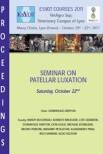Osteoarthritis (OA) is a chronic, degenerative disease affecting the articular cartilage and subchondral bone that causes pain and inhibits movement. The stifle's joint fibrous capsule contains the synovial membrane, which produces cartilage nutrients. A ruptured cranial cruciate ligament injures the joint and produces OA.
Osteoarthritis diagnosis starts with clinical radiographic and ultrasonographic tests, although the latter is not used very much in dog and cat clinics for this purpose. The objective of this study was to establish the correlation among the results of orthopedic, radiographic, ultrasonographic examinations and structural anatomical changes revealed by arthroscopic evaluation to diagnose stifle joint OA and determine risk factors in the dogs affected.
Of 44 clinical cases of OA included in the study, 88.64% had ruptured of cranial cruciate ligaments. The correlation between synovial fluid effusion and osteophytosis was of 0.84.
It was concluded that there is good diagnostic agreement between synovial fluid effusion and osteophytosis when dealing with stifle joint OA. Risk factors for dogs regarding the development of stifle joint OA included: ruptured cranial cruciate ligaments or patella luxation, female dogs and weight over 10 kg.









